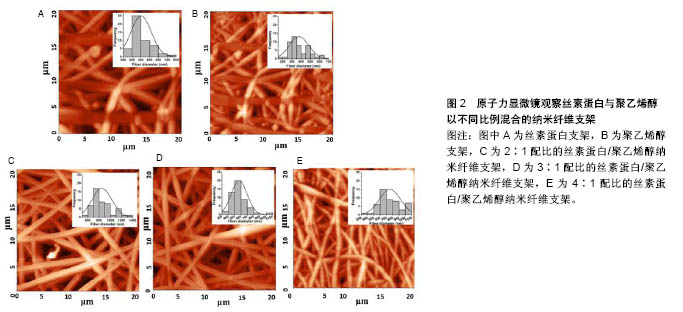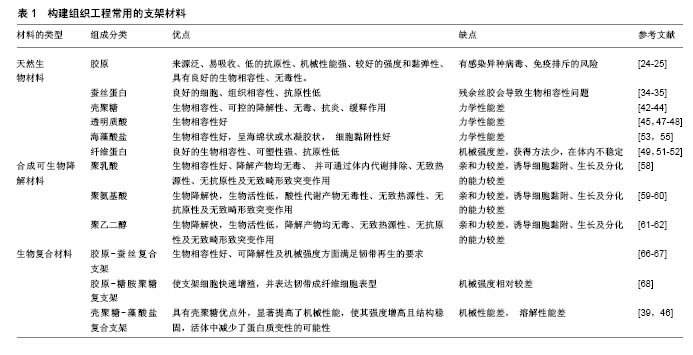| [1] Langer R.Tissue engineering.Science. 2000;260(5110):920-926.[2] World Health Organization.Men, ageing and health: Achieving health across the life span.2001.[3] Santos ML,Rodrigues MT,Domingues RMA,et al.Biomaterials as Tendon and Ligament Substitutes: Current Developments// Regenerative Strategies for the Treatment of Knee Joint Disabilities. Springer International Publishing, 2017:349-371.[4] Makris EA,Gomoll AH,Malizos KN,et al.Repair and tissue engineering techniques for articular cartilage.Nat Rev Rheumatol. 2015;11(1):21-34.[5] Tatara AM,Mikos AG.Tissue engineering in orthopaedics. JBJS. 2016;98(13):1132-1139.[6] Graber LW,Vanarsdall RL,Vig KW,et al.Orthodontics-E-Book: Current Principles and Techniques. Elsevier Health Sciences, 2016.[7] Schreiber SL.Chemical Biology Towards Precision Medicine. Israel J Chem.2017; 57(3-4):174-178.[8] Nuelle CW,Cook JL,Gallizzi MA,et al.Posterior single-incision semitendinosus harvest for a quadrupled anterior cruciate ligament graft construct: determination of graft length and diameter based on patient sex, height, weight, and body mass index.Arthroscopy.2015;31(4):684-690.[9] Sena M,Chen J,Dellamaggioria R,et al. Dynamic evaluation of pivot-shift kinematics in physeal-sparing pediatric anterior cruciate ligament reconstruction techniques.Am J Sports Med. 2013;41(4): 826-834.[10] Cain EL Jr,Fleisig GS,Ponce BA,et al.Variables Associated with Chondral and Meniscal Injuries in Anterior Cruciate Ligament Surgery.J Knee Surg.2016;30(7):659-667.[11] Vacanti CA.History of tissue engineering and a glimpse into its future.Tissue Eng Part A.2006; 12(5):1137-1142. [12] Pina S,Oliveira JM,Reis RL.Natural-based nanocomposites for bone tissue engineering and regenerative medicine: a review.Adv Mater.2015;27(7):1143-1169.[13] Yuan T,Zhang L,Li K,et al. Collagen hydrogel as an immunomodulatory scaffold in cartilage tissue engineering.J Biomed Mater Res B Appl Biomater.2014;102(2):337-344.[14] Shrivats AR,McDermott MC,Hollinger JO.Bone tissue engineering: state of the union.Drug Discov Today. 2014;19(6):781-786. [15] Chen FM,Liu X.Advancing biomaterials of human origin for tissue engineering. Prog Polym Sci.2016;53:86-168.[16] Hirukawa M,Katayama S,Sato T,et al.Development of Tissue-Engineered Ligaments: Elastin Promotes Regeneration of the Rabbit Medial Collateral Ligament. Artif Organs.2017 Dec 21. doi: 10.1111/aor.13066. [Epub ahead of print][17] Yu L,Huang J,Wang J,et al.Antler collagen/chitosan scaffolds improve critical calvarial defect healing in rats.J Biomater Tissue Eng.2015;5(10):774-779.[18] Zhang D,Wu X,Chen J,et al.The development of collagen based composite scaffolds for bone regeneration.Bioact Mater. 2018; 3(1):129-138.[19] Aravamudhan A,Ramos DM,Nip J,et al.Micro-Nanostructures of Cellulose-Collagen for Critical Sized Bone Defect Healing. Macromol Biosci. 2018;18(2).doi:10.1002/mabi.201700263. Epub 2017 Nov 27.[20] Kämmerer PW,Scholz M,Baudisch M,et al.Guided Bone Regeneration Using Collagen Scaffolds, Growth Factors, and Periodontal Ligament Stem Cells for Treatment of Peri-Implant Bone Defects In Vivo.Stem Cells Int. 2017;2017:3548435..[21] Mti M,Kitamura N,Nonoyama T,et al.Anisotropic tough double network hydrogel from fish collagen and its spontaneous in vivo bonding to bone.Biomaterials.2017;132:85.[22] Nehrer S,Breinan HA,Ramappa A,et al.Canine chondrocytes seeded in type I and type II collagen implants investigated in vitro.J Biomed Mater Res A.1997;38(2):95-104. [23] Clark RAF,Ghosh K,Tonnesen MG.Tissue engineering for cutaneous wounds. J Invest Dermatol. 2007;127(5):1018-1029.[24] Attia E,Bohnert K,Brown H,et al. Characterization of total and active matrix metalloproteinases-1, -3, and -13 synthesized and secreted by anterior cruciate ligament fibroblasts in three- dimensional collagen gels.Tissue Eng Part A. 2014; 20(1-2): 171.[25] Shen W,Chen X,Hu Y,et al.Long-term effects of knitted silk–collagen sponge scaffold on anterior cruciate ligament reconstruction and osteoarthritis prevention.Biomaterials. 2014; 35(28):8154-8163.[26] Khamhaengpol A,Siri S.Composite Electrospun Scaffold Derived from Recombinant Fibroin of Weaver Ant(Oecophylla smaragdina) as Cell-Substratum.Appl Biochem Biotechnol. 2017;183(1):1-16.[27] Burke KA,Roberts DC,Kaplan DL.Silk Fibroin Aqueous-Based Adhesives Inspired by Mussel Adhesive Proteins. Biomacromolecules.2015;17(1):237.[28] Ma D,Wang Y,Dai W.Silk fibroin-based biomaterials for musculoskeletal tissue engineering. Mater Sci Eng C Mater Biol Appl.2018; 89:456-469.[29] Sahu N,Baligar P,Midha S,et al.Nonmulberry Silk Fibroin Scaffold Shows Superior Osteoconductivity Than Mulberry Silk Fibroin in Calvarial Bone Regeneration.Adv Healthc Mater. 2015;4(11): 1709-1721.[30] Bhawal UK,Uchida R,Kuboyama N,et al.Effect of the surface morphology of silk fibroin scaffolds for bone regeneration. Biomed Mater Eng.2016;27(4):413.[31] Bhattacharjee P,Kundu B,Naskar D,et al.Silk scaffolds in bone tissue engineering: An overview. Acta Biomaterialia. 2017;63:1-17.[32] Aigner TB,Desimone E,Scheibel T.Biomedical Applications of Recombinant Silk-Based Materials. AdvMater.2018:1704636.[33] Pillai MM,Gopinathan J,Indumathi B,et al.Silk-PVA Hybrid Nanofibrous Scaffolds for Enhanced Primary Human Meniscal Cell Proliferation.J Membr Biol.2016;249(6):1-10.[34] Jiang T,Kumbar SG,Nair LS,et al.Biologically active chitosan systems for tissue engineering and regenerative medicine. Curr Top Med Chem.2008;8(4):354-364.[35] d'Ayala GG,Malinconico M,Laurienzo P. Marine derived polysaccharides for biomedical applications: chemical modification approaches.Molecules.2008;13(9):2069-2106.[36] Venkatesan J,Bhatnagar I,Kim SK.Chitosan-alginate biocomposite containing fucoidan for bone tissue engineering. Marine Drugs.2014;12(1):300-316.[37] Kim IY,Seo SJ,Moon HS,et al.Chitosan and its derivatives for applications.Biotechnol Adv.2008;26:1-21.[38] Liu Y,Wang S,Zhang R.Composite poly(lactic acid)/chitosan nanofibrous scaffolds for cardiac tissue engineering.Int J Biol Macromol.2017;103:1130-1137.[39] Silva JM,Rodrigues LC,Silva SS,et al.Engineered tubular structures based on chitosan for tissue engineering applications.J Biomater Appl.2018;32(7):841-852.[40] Chameettachal S,Murab S,Vaid R,et al.Effect of visco-elastic silk-chitosan microcomposite scaffolds on matrix deposition and biomechanical functionality for cartilage tissue engineering. J Tissue Eng Regen Med.2017;11(4):1212-29.[41] Gholizadeh S,Moztarzadeh F,Haghighipour N,et al.Preparation and characterization of novel functionalized multiwalled carbon nanotubes/chitosan/ beta-Glycerophosphate scaffolds for bone tissue engineering. Int J Biol Macromol.2017;97:365-372.[42] Boukari Y,Qutachi O,Scurr DJ,et al.A dual-application poly (dl-lactic-co-glycolic) acid (PLGA)-chitosan composite scaffold for potential use in bone tissue engineering. J Biomater Sci Polym Ed.2017;28(16):1966-1983.[43] Venkatesan J,Bhatnagar I,Manivasagan P,et al.Alginate composites for bone tissue engineering: a review.Int J Biol Macromol.2015;72:269-281.[44] Bidarra SJ,Barrias CC,Granja PL.Injectable alginate hydrogels for cell delivery in tissue engineering.Acta Biomaterialia. 2014;10(4): 1646-1662.[45] Liu Y,Ai K,Lu L.Polydopamine and its derivative materials: synthesis and promising applications in energy, environmental, and biomedical fields.Chem Rev. 2014;114(9):5057-5115. [46] Almeida H,Sathy BN,Dudurych I,et al.Anisotropic Shape-Memory Alginate Scaffolds Functionalized with either Type I or Type II Collagen for Cartilage Tissue Engineering. Tissue Eng Part A. 2016;23(1-2):55-68.[47] Santoro M,Shah SR,Walker JL,et al.Poly (lactic acid) nanofibrous scaffolds for tissue engineering.Adv Drug Deliv Rev. 2016;107: 206-212.[48] Nakao H,Jacquet RD,Shasti M,et al.Long-Term Compari60son between Human Normal Conchal and Microtia Chondrocytes Regenerated by Tissue Engineering on Nanofiber Polyglycolic Acid Scaffolds.Plast Reconstr Surg. 2017;139(4):911e-921e.[49] Murdock MH,Badylak SF.Biomaterials-based in situ tissue engineering.Curr Opin Biomed Eng. 2017;1:4-7.[50] Shih YC.Effects Of Degradation On Mechanical Properties Of Tissue-Engineering Poly (glycolic Acid) Scaffolds (2015).Yale Medicine Thesis Digital Library. 2011. http://elischolar.library. yale.edu/ymtdl/2011 2015.[51] Gentile P,Chiono V,Carmagnola I,et al.An overview of poly (lactic-co-glycolic) acid (PLGA)-based biomaterials for bone tissue engineering.Int J Mol Sci.2014;15(3):3640-3659.[52] Elsawy MA,Kim KH,Park JW,et al.Hydrolytic degradation of polylactic acid (PLA) and its composites.Renewa Sust Energy Rev.2017;79:1346-1352.[53] Bach JS,Detrez F,Cherkaoui M,et al.Hydrogel fibers for ACL prosthesis: design and mechanical evaluation of PVA and PVA/UHMWPE fiber constructs.J Biomech. 2013;46(8): 1463-1470.[54] Naahidi S,Jafari M,Logan M,et al.Biocompatibility of hydrogel-based scaffolds for tissue engineering applications. Biotechnol Adv.2017;35(5):530-544. [55] Wang J,Yang Q,Cheng N,et al.Collagen/silk fibroin composite scaffold incorporated with PLGA microsphere for cartilage repair. Mater Sci Eng C.2016;61:705-711.[56] Fernandez-Yague MA,Abbah SA,McNamara L,et al.Biomimetic approaches in bone tissue engineering: Integrating biological and physicomechanical strategies. Adv Drug Deliv Rev.2015;84:1-29.[57] Hoogenkamp HR.Novel Collagen-based Scaffolds For Hollow Organ Regeneration[M].[Sl:sn],2015.[58] Wojak-Cwik IM,Hintze V,Schnabelrauch M,et al.Poly (L‐lactide‐co‐glycolide) scaffolds coated with collagen and glycosaminoglycans: Impact on proliferation and osteogenic differentiation of human mesenchymal stem cells.J Biomed Mater Res A.2013;101(11):3109-3122.[59] Sajesh KM,Jayakumar R,Nair SV,et al.Biocompatible conducting chitosan/polypyrrole–alginate composite scaffold for bone tissue engineering.Int J Biol Macromol. 2013;62:465-471.[60] Au H,Rubio N,Shaffer MSP.Brominated graphene as a versatile precursor for multifunctional grafting.Chem Sci. 2018;9(1):209-17.[61] Fan Z,Wang J,Wang Z,et al.One-pot synthesis of graphene/hydroxyapatite nanorod composite for tissue engineering. Carbon.2014;66(1):407-416.[62] Chen C,Zhang Q,Ma T,et al.Synthesis and Electrochemical Properties of Nitrogen-Doped Graphene/Copper Sulphide Nanocomposite for Supercapacitor. Journal of nanoscience and nanotechnology. 2017;17(4):2811-816.[63] Zhang B,Wang Y,Zhai G,et al.Biomedical applications of the graphene -based materials.Mater Sci Eng C. 2016;61(8): 953-964.[64] Holt BD,Wright ZM,Arnold AM,et al.Graphene oxide as a scaffold for bone regeneration.Wiley Interdiscip Rev Nanomed Nanobiotechnol.2017;9(3).doi:10.1002/wnan.1437. Epub 2016 Oct 26. Review.[65] Jafari M,Paknejad Z,Rad MR,et al.Polymeric scaffolds in tissue engineering: a literature review.J Biomed Mater Res B Appl Biomater.2015;105(2):431-459.[66] Gong T,Xie J,Liao J,et al.Nanomaterials and bone regeneration. Bone Res.2015;3(3):123-129.[67] Wang CH,Guo ZS,Pang F,et al.Effects of Graphene Modification on the Bioactivation of Polyethylene-Terephthalate-Based Artificial Ligaments.ACS Appl Mater Interfaces. 2015;7:15263-15276.[68] Zhang S,Yang Q,Zhao W,et al.In vitro and in vivo biocompatibility and osteogenesis of graphene-reinforced nanohydroxyapatite polyamide66 ternary biocomposite as orthopedic implant material. Int J Nanomedicine. 2016;11:3179-3189. |
.jpg)


.jpg)
.jpg)